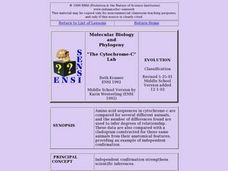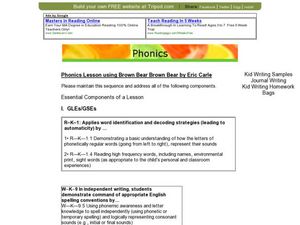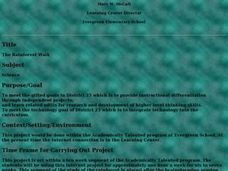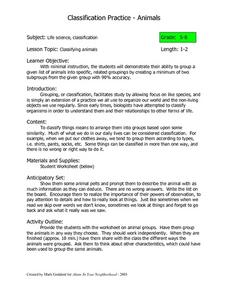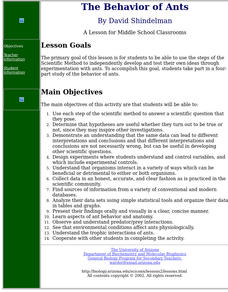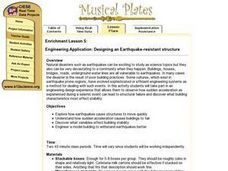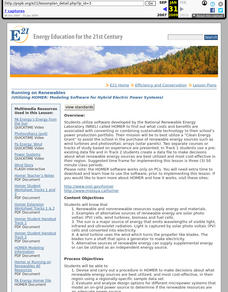Curated OER
Farming Fantastic Friends
Seventh graders demonstrate scientific inquiry to design and perform an experiment involving Grow Creatures. They participate in a class discussion, and in small groups design an experiment that determines how to change the materials to...
Curated OER
Civil War Letter Web
Students use the internet to gather information on a specific Civil War battle of interest to them. Using the information they gather, they organize it into a web to be used later when writing a letter. They use the web to write their...
Curated OER
Introduction to Genealogy
Students investigate their own family's genealogy by conducting oral interviews and doing Internet research. In a series of activities, students acquire inquiry and research skills, develop an appreciation of their heritage, and classify...
Curated OER
Nobel Peace Prize Winners
Students work in groups to complete biography overviews and research, organize information and decorate masks to look like their assigned Nobel Peace Prize winner. They present their information to the class as a group then independently...
Curated OER
Abraham Lincoln
First graders explore famous people in America. They read and discuss a story about Abraham Lincoln. After the class discussion, 1st graders create a web of important events in the life of Abraham Lincoln. Finally, students write...
Curated OER
The Cytochrome-C Lab
Students examine a method biologists use to try to determine relationships. They examine how amino acid sequences have been determined for a number of proteins, and how scientists can make inferences about DNA based on the amino acid...
Curated OER
Crash Test Physics
Learners design and test balsa cars. In this crash tet instructional activity, students design and build their own cars to specifications. They explore the physics of motion and vehicle crash safety.
Curated OER
Genetics Challenge
In this genetics worksheet, students fill in the blanks with terms related to genes, alleles, genotypes, phenotypes and heredity. They use their answers to complete a joke.
Curated OER
Who Dirtied The Water/Clean Water: Is It Drinkable?
Students enter the room, receive a film canister that contains materials that be added to the dirty water bell jar. They record on their data table who or what is doing the adding and the actual substance that has been added to the bell...
Curated OER
Brown Bear Phonics
Students listen to Brown Bear, Brown Bear and imitate the style of Eric Carle in writing a sentence. In this writing lesson, students use the beginning and ending sounds of words to write an Eric Carle type sentence. ...
Curated OER
My Community
First graders design a Powerpoint presentation to reflect information about their community. In this community lesson, 1st graders create slides to explain the weather, geography and other information about the city.
Curated OER
The Rainforest Walk
Fourth graders research the characteristics and inhabitants of the rainforest. They demonstrate their ability to communicate using e-mail and create a class presentation of their research.
Curated OER
Modeling Hot and Cold Planets
Young scholars, in teams, design and construct models of two planets, one hot and the other cold, using a variety of materials. They attempt to create the models out of substances that will actually show the greatest temperature...
Alabama Learning Exchange
Edible Cell
Students identify cell parts and their function. For this animal cell lesson, students view a video clip and discuss cell components. Students create an edible replica of an animal cell using food items.
Curated OER
The Missing Piece: A Tale of a Tail
Students analyze and write about their findings of the dinosaur discoveries of Edward Cope. For this Edward Cope lesson plan, students examine illustrations of concept maps, discuss challenges, analyze skeleton diagrams, and write...
Curated OER
Classification Practice-Animals
Students use pictures of animals to make a classification system. In this classification lesson plan, students are given pictures of different animals. They create a classification system for the animals and identify what they have in...
Curated OER
Meiosis and Sexual Reproduction
Eighth graders are able to define meiosis. They are able to compare and contrast meiosis and mitosis. Students are able to state the phases of meiosis. They complete a K-W-L chart on meiosis and mitosis. Students talk about meiosis...
Curated OER
The Behavior of Ants
Students use the steps of the Scientific Method to develop and test their own ideas through experimentation with ants.
Curated OER
Designing an Earthquake-resistant Structure
Students attempt to design and build the most stable "earthquke resistant" structure. They create model buildings and test them on a shake table to see which design holds up the best.
Curated OER
Marine Life, Oceans, Lakes and Rivers
Students examine the types of organisms found in oceans. In groups, they read articles about the research done at certain sites. They work together to research their own water ecosystems and report the findings to the class. To end...
Curated OER
How Do We Use Scientific Inquiry To Solve the World's Problems?
Ninth graders examine how a scientific investigation is performed. They read and discuss examples of various scientific experiments, design an experiment involving fast growing plants, and create graphs and charts to present their...
Curated OER
The Effects of Alcohol and other Teratogens: A model using Zebrafish
Students investigate the interference of various drugs on an embryo through experimentation. This is an open-ended lab to allow students to see effects of various chemicals humans choose to put in their bodies and create questions they...
Curated OER
Running on Renewables
Students investigate the costs and benefits of switching their school to sustainable technology energy production. They use software called HOMER developed by the National Renewable Energy Lab to do the cost/ benefit analysis. They then...
Curated OER
AP Chemistry-Chemical Kinetics
In this kinetics learning exercise, students find rate laws of reactions, they determine rate constants, they find rate-determining steps of reactions, they find half-life's of reactions and they determine the overall order of reactions.





